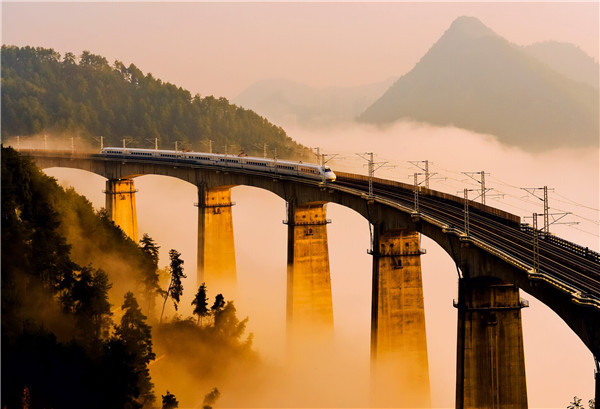How the railways moved fast-forward
By Mei Jia (China Daily) Updated: 2016-12-28 07:14In a new book, veteran expert Wang Xiong explains how China became a world leader in high-speed transport, Mei Jia reports.
As the Spring Festival rush approaches, the railways are in focus again.
By the end of last year, China had 121,000 kilometers of train track. Of that, 19,000km were high-speed lines, covering all Chinese cities with a population larger than 500,000 and accounting for 60 percent of the world's high-speed lines.
The clean-energy electric multiple unit (EMU) trains have become a favorite choice for travelers both inside and outside the country. And as railways become a golden calling card for Chinese manufacturing overseas, the industry faces challenges and questions.
Wang Xiong, who has witnessed and participated in the development of high-speed rail, has written a first-of-its-kind book on these cutting-edge railways, recounting the 25-year history of its development and answering many of the questions raised.
China Speed: Development of China's High Speed Rail has been released simultaneously in Chinese and English by Foreign Language Press. The English version is already a hit at book fairs, like the recent Peru's Lima International Book Fair.
"It's actually a biography of the country's high-speed rail, a testimony to its safety and reliability and an instructive guide," says Wang Yang, the book's editor.
Wang Xiong says it's wrong to say that China's HSR was an overnight success. After interviews with more than 100 engineers, operators, officials, constructors, drivers and attendants, he says it's a result of joint efforts in many areas since 1990.
His book targets sensitive topics like ticket prices, investment, intellectual property and diplomacy. He has even followed online forums to find out what the public most wants to know.
"The only way is to face questions and explain them truthfully," the author says in his office at the People's Railway Daily, near Beijing West Railway Station, where he serves as the president of the newspaper.
The book offers 2,600 statistics about HSR, supplemented with 50 photos, some rarely seen.
"There are no standard answers in my book. Different interviewees give varied ideas, which added to the difficulty of writing," Wang Xiong says.
He believes China is a global leader "in HSR bridges, tunnels and roadbeds, as well as track structure and EMU technology".
He says the record speed for an operational train is 486.1 kilometers per hour. It was recorded in a test for the Beijing-Shanghai HSR in December 2010.
"HSR is the scientific innovation that can directly bring tangible benefits to people," says Wang Xiong.
David Ferguson, an international media expert, says: "China's HSR very much merits a book, and this one does justice to the topic. The author uses his encyclopedic knowledge to provide concrete characters and fascinating stories.
"The English version is a valuable resource to people outside China who want to know how China progressed from a learner to a teacher of HSR."
Wang Xiong was born in 1957 in Hubei province. He was a driver of steam trains in the late 1970s before attending Suzhou Railway Institute (now known as Suzhou University of Science and Technology) for his degrees, majoring Chinese language and literature.
"My job was to throw coal into the stove - about 5 tons for one shift - and later I became the second driver on a team of three,"Wang Xiong recalls.
That period, he says, was the most tiring of his life. But he was fortunate enough to get a complete picture of all the jobs required to maintain trains.
A fan of literature since his youth, he reads extensively and is influenced greatly by the short stories of Wang Zengqi and French writer Emile Zola.
"I used to read at night using oil lamps. In the morning when people saw me, I had black ash stuck in my nostrils," says Wang Xiong.
He later worked with the railway publicity department, while writing novels and essays about railways and "Hanshui River Culture", centering in Xiangyang city in his home province, Hubei.
An English-language novel, entitled The Time-Honored Patina, is to be released soon.
Speaking of rail tragedies, Wang Xiong says he was at the scene of the tragic D301 train accident in Wenzhou in 2011,which killed 40 people.
"I stayed there for a month. I felt sad and touched. But I think when meeting with frustrations on the way to development, we should not give up," he says. "And we should convey what we've been doing to the world readers."
After the accident, Wang Xiong planned the book, though HSR was still a sensitive topic, connected with corruption cases involving railway officials responsible for the tragedy.
Famed writer Li Chunlei thinks Wang is the right person, and perhaps the only person,who can deal with the railway story properly, considering his experience, resources and training.
"I tried the topic myself around 2010, and I visited people and rode on the HSR, but it still was beyond my range, and I stopped," says Li.
"Wang writes with accuracy and warmth, and his book is subjective and well-grounded. His judgment and sensitivity have helped him deal with the many controversies and disputes related to the topic," says Li.
"He fills in a blank."
Contact the writer at meijia@chinadaily.com.cn
|
 China is home to 60 percent of the world's high-speed lines. Photos Provided To China Daily |
- 'Cooperation is complementary'
- Worldwide manhunt nets 50th fugitive
- China-Japan meet seeks cooperation
- Agency ensuring natural gas supply
- Global manhunt sees China catch its 50th fugitive
- Call for 'Red Boat Spirit' a noble goal, official says
- China 'open to world' of foreign talent
- Free trade studies agreed on as Li meets with Canadian PM Trudeau
- Emojis on austerity rules from top anti-graft authority go viral
- Xi: All aboard internet express











